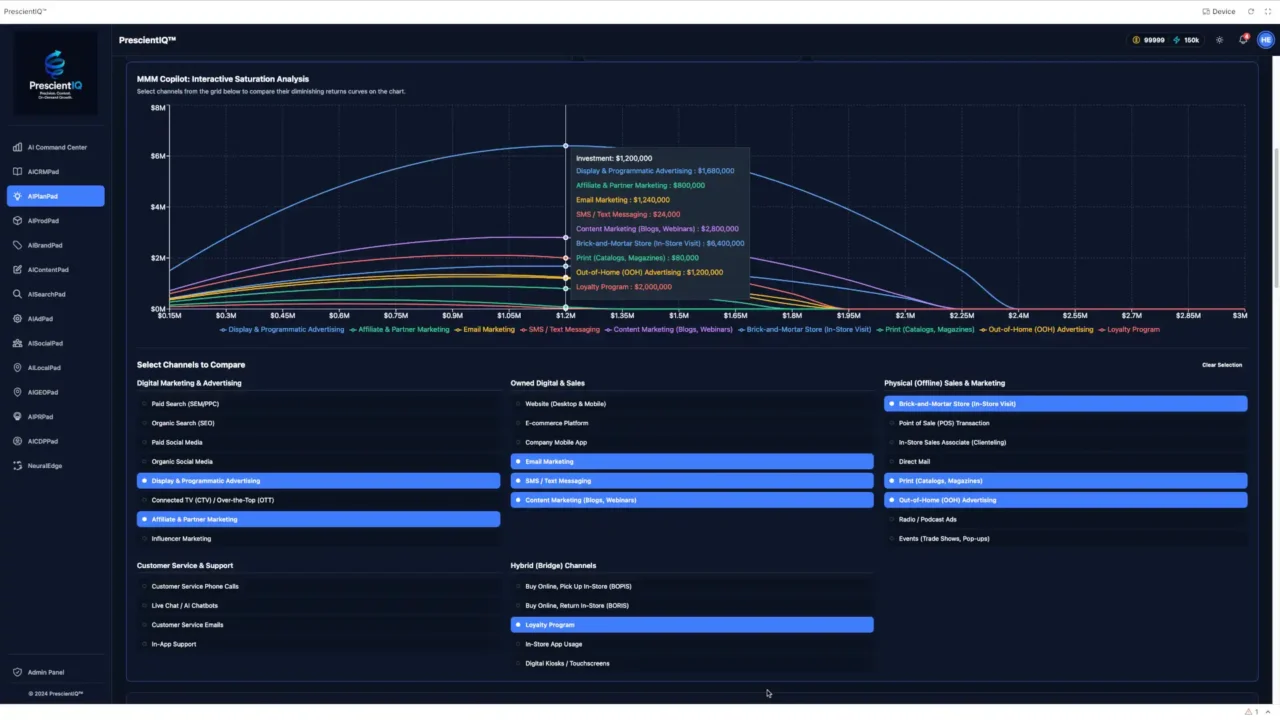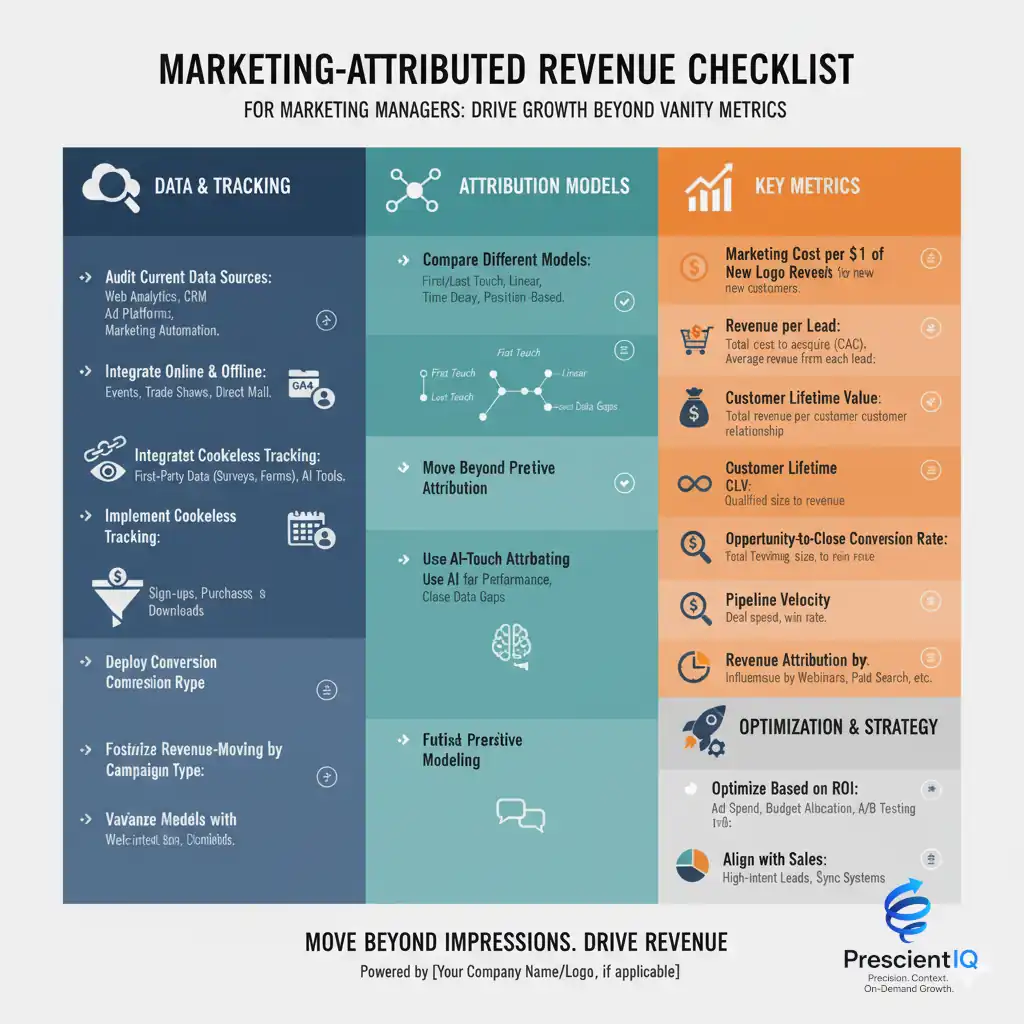From Experimentation to Evidence: How Your Marketing Team Can Adopt an AI-ROI Operating System
From Experimentation to Evidence: How Your Marketing Team Can Adopt an AI-ROI Operating System.
For marketing managers & executives at MMG-client organisations.
1. The new frontier of AI investment in marketing
Marketing organisations are under increasing pressure to show measurable value from AI initiatives.
Many businesses invest in shiny tools – generative AI, personalization engines, predictive models – yet still struggle to answer the core question: “What’s the return on this for my marketing budget?”
According to recent research, fewer than 30% of enterprise AI pilots progress beyond the proof-of-concept stage. (AI Marketing That Thinks Ahead.)
At MMG, we see the same: great marketing-AI experiments, but the finance and leadership teams say, “show us the dollars.”
For marketing managers and executives, this means: you can’t just deploy a new AI tool and hope it drives superior performance.
You must validate, up front, the causal impact on outcomes that matter (net-new revenue, customer lifetime value (CLV), cost per lead, etc.).
That’s where adopting an “AI ROI Operating System” mindset becomes a differentiator.
2. Why marketing ROI is broken – and why marketing teams feel it
Marketing departments face specific headwinds when it comes to AI ROI:
- Attribution complexity: Modern marketing ecosystems have many touch-points (social, search, email, display, etc). It’s difficult to isolate the true causal impact of a new AI tool on the final conversion.
- Vanity metrics vs financial outcomes: Metrics like CTR, open-rate, or engagement are important—but what your CFO cares about is incremental revenue, CLV uplift, or margin improvement. Marketing teams often optimise for the former and struggle to translate into the latter.
- Black-box AI & trust: If your AI or personalization engine is opaque, it becomes harder to defend the investment to leadership or regulatory/compliance stakeholders.
- Rapid volatility in marketing conditions: Consumer behavior changes, ad costs shift, platforms evolve (e.g., cookie policies). A pilot that works today may not sustain for more than 6 months.
For marketing executives, this means: your credibility is at stake.
You need to move from “we tried this AI tool” to “we know this AI tool will generate $X more revenue / reduce cost by $Y in the next 12 months”.
Decision Journey Explorer
Explore the 4S behaviors—Streaming, Scrolling, Searching, and Shopping—with adaptive contrast and an accessible diagram.
Flow & Influence Map — Technical Validation Bias
Streaming Awareness → Authority
Webinars, product demos, and podcasts that showcase applied AI/data outcomes.
Industry briefings, analyst interviews, and case videos to build credibility.
Recommended tactics
- Anchor series (monthly) + on-demand library
- Repurpose to shorts/snippets for social amplification
- Contextual CTAs to “Try the sandbox” or “Book a demo”
Scrolling Discovery → Recall
Short-form posts, infographics, and employee advocacy highlight use-cases & wins.
LinkedIn carousels, analyst quotes, and insight-of-the-week clips drive engagement.
Recommended tactics
- Editorial calendar with “snackable” narratives
- Influencer/SME collaboration to extend reach
- UTM discipline to connect social → search → trial
Searching Intent → Validation
SEO pages, technical blogs, interactive comparisons, and AI site search for answers.
“How to implement CI”, platform comparisons, and whitepapers with ROI evidence.
Recommended tactics
- Solution & industry pages mapped to high-intent queries
- Schema markup + internal “semantic search” assistant
- Proof assets: case studies, benchmarks, calculators
Shopping Conversion → Value
Free trials/sandboxes, transparent pricing, guided onboarding, and live support.
Guided demo booking, limited-data trial/POC, ROI simulation, easy contracting.
Recommended tactics
- One-click sign-up with SSO + progressive profiling
- In-app tours, checklists, and success milestones
- Rev-ops triggers for timely human assist
3. The Solution: Simulation-First Marketing with an AI ROI Operating System
The concept: before you commit budget to a full-scale AI tool or platform, first simulate its impact within your marketing operations.
Validate the business case, map the causal links, and surface constraints. This is the “simulation-first” approach.
In MMG’s consulting context, you can help marketing teams move from “let’s pilot this” to “let’s simulate, then invest”.
Here’s how it works in a marketing setting:
- Data ingestion: Gather historical marketing performance: campaign data, channel spend, conversion rates, customer journeys, CLV, average order value, etc.
- Simulate “what-if” scenarios: For example, if you deploy an AI-driven personalization engine in email marketing, what is the expected uplift in conversions? What are the downstream effects on order value, repeat rate, and margin? What are the operational constraints (inventory, supply chain, fulfilment) that might limit upside?
- Deliver board-ready output: Generate a dashboard and executive presentation showing estimated revenue impact, cost savings, risk bounds, and confidence intervals. So marketing leaders can go to the C-suite with a defensible case.
Example for a marketing manager: Suppose you’re launching an AI tool to optimise ad bidding and creative personalization.
A simulation might show: “If CTR goes up 15% (tool claim) → traffic increases by X → conversion improves by Y → order value increases by Z → incremental revenue of $850k/quarter, BUT inventory constraints may limit upside by 70% unless addressed.” (This mirrors an example from the original article.)
By doing this, the marketing team can:
- Justify the budget to the CFO/CMO with numbers
- surface operational risks before rollout
- Align channel, content, and operations around expected outcomes
- move faster and with greater confidence Agent as a Service: Faster, Cheaper, and Better Marketing
4. Why this matters for marketing managers & marketing executives
For Marketing Managers:
- You gain a tool to prioritise AI initiatives: instead of “which tool sounds cool”, you choose “which tool gives the best predicted ROI”.
- You reduce the risk of launching a technology that doesn’t deliver the expected results, protecting your reputation and budget.
- You strengthen your ability to partner with data/analytics teams and speak the business finance language (revenue, cost, margin) rather than just engagement metrics.
For Marketing Executives (CMO, VP Marketing):
- You gain a predictable way to evaluate AI investments across channels and tools, standardising how you measure impact.
- You get a unified language to speak with finance, operations, and the board—not just about “improving metrics,” but about “unlocking $X in revenue” and “reducing cost by $Y.”
- You accelerate time-to-value: Instead of pilots that drag on for months, you move to validated business cases in weeks, allowing you to scale faster.
5. How MMG can help you adopt this mindset
At Matrix Marketing Group, our consulting approach for marketing teams includes:
- Use-case selection: We work with you to identify the highest-leverage AI marketing use cases (e.g., personalisation, channel optimization, predictive segmentation).
- Simulation & modelling: We build simulation frameworks (historical data ingestion, causal modelling, scenario planning) to validate ROI before tool acquisition.
- Operational readiness assessment: We help surface hidden operational constraints (inventory, fulfilment, attribution gaps, channel interdependencies) that could limit ROI.
- Executive reporting and alignment: We deliver board-ready dashboards and presentation decks so you can communicate with leadership in the language of dollars and impact.
- Scaling roadmap: After simulation and validation, we help you plan rollout and scale-up, with tracking and governance to ensure value realisation.
6. Your next steps for an AI-ROI Operating System

Here’s a recommended path for marketing leaders who want to adopt this approach:
- Step 1: Audit your current AI or advanced analytics initiatives. Which ones have a clear business case? Which are still experimental?
- Step 2: Choose one pilot you want to validate via simulation. Gather the relevant data (campaign performance, funnel metrics, customer values, costs).
- Step 3: Work with MMG to build the simulation: define assumptions, run scenarios, surface risk, and upside.
- Step 4: Present the simulation results to your executive team: show projected revenue/cost impact, confidence intervals, causal path, next-step recommendations.
- Step 5: Based on validated results, commit budget and plan execution. Include tracking mechanisms to compare actual vs simulated outcomes.
- Step 6: Scale successful use cases across channels and adopt this simulation-first mindset across your marketing organisation.
The Solution: Simulation-as-a-Service – AI-ROI Operating System

Aether’s insight is both simple and radical: enterprises should be able to validate AI outcomes before deployment, just as engineers test designs before manufacturing.
This idea defines the emerging category of Simulation-as-a-Service (SimSaaS)—a software layer that models the causal impact of AI interventions within a secure, isolated environment.
It allows executives to simulate “what if” scenarios, quantify efficiency deltas, and visualize ROI before investing in full-scale adoption.
The 14-Day ROI Cycle
Aether’s most powerful innovation is speed. Traditional AI validation takes months. Aether delivers quantified ROI projections in under 14 days, using a low-friction engagement model:
- Data ingestion into a secure, single-tenant GCP sandbox.
- Automated causal simulation runs using Aether’s proprietary engine.
- Delivery of a Looker-based ROI dashboard and executive boardroom deck—both automatically generated.
This isn’t a consulting engagement. It’s SaaS precision applied to strategic foresight.
Security and Compliance by Design
Aether’s architecture aligns with enterprise-grade compliance standards, including SOC 2, GDPR, and AES-256 encryption. Data never leaves the sandbox; simulations run in isolation, ensuring both security and reproducibility.
For industries like healthcare and finance, this creates a trust layer that no black-box AI vendor can match.
From Proof-of-Concept to Proof-of-Value

Simulation-as-a-Service represents a paradigm shift: from proof of concept (PoC) to proof of value (PoV).
Traditional PoCs demonstrate that AI “can” work; PoVs prove that AI “will” work—and quantify how well.
By automating the simulation of outcomes, Aether eliminates subjective interpretation and replaces it with empirical validation.
Financial Justification for AI Adoption and AI-ROI Operating System
Executives can now justify AI initiatives using defensible data. The platform translates model performance into:
- Efficiency Deltas: Quantified productivity or cost improvements.
- Variance Analysis: Confidence intervals for expected outcomes.
- Causal Attribution: Visibility into why an AI system drives those outcomes.
This creates boardroom-ready investment cases that move AI from “experimental spend” to “strategic capital allocation.”
Standardizing ROI Across Departments
Because Aether’s simulations use a unified framework, organizations can compare performance across departments and vendors—standardizing how AI impact is measured enterprise-wide.
Marketing, operations, and finance now speak a shared language of ROI rather than isolated metrics.
Accelerating Enterprise Adoption
By validating outcomes before procurement, departments can move faster with lower risk.
The “simulation-first” approach reduces time-to-value, shortens sales cycles, and increases stakeholder confidence—transforming AI adoption from an act of faith into a process of verification.
The Aether Advantage: Transparency, Trust, and Time-to-Value

Transparent AI
Aether’s simulations are fully auditable. Every projection is accompanied by confidence scores, causal path maps, and explainable deltas.
This transparency differentiates Aether from legacy ROI calculators and opaque machine learning platforms.
Executives can trace each efficiency gain to its underlying causal driver—transforming AI from a black box into a boardroom dashboard. The AI Talent Gap: Your Most Critical Obstacle to Marketing ROI
Trust Through Isolation
Data isolation isn’t a feature; it’s a philosophy.
Aether’s single-tenant simulation environments ensure no cross-customer data contamination.
Enterprises maintain full data custody while leveraging Aether’s computation engine—a critical differentiator for regulated sectors.
Time-to-Value and AI-ROI Operating System
The combination of automation, causal modeling, and pre-trained simulation templates enables Aether to deliver results in two weeks rather than two quarters.
In markets where speed defines competitive advantage, this is transformative.
Quantifiable Results
Pilot data from early adopters show:
- 35%+ simulation-to-subscription conversion
- 14-day validation cycles
- 9/10 post-demo NPS
These metrics reinforce Aether’s position not just as a product, but as a catalyst for the next phase of AI transformation.
The SaaS Transformation Story: Simulation as the Next Platform Layer
From Software to Simulation
Over the last two decades, SaaS has evolved from on-premise tools to cloud platforms, and now—through Simulation-as-a-Service—to predictive foresight systems.
Each phase increased abstraction and reduced friction:
- SaaS 1.0: Access software anywhere.
- SaaS 2.0: Automate processes everywhere.
- SaaS 3.0: Simulate outcomes before you execute.
Aether represents SaaS 3.0—where value lies not in executing workflows but in forecasting which workflows will generate measurable returns.
Integration with Enterprise Ecosystems
Aether’s API layer enables direct integration with CRM and MarTech systems such as Salesforce, HubSpot, and Marketo. This turns simulation into a native feature of enterprise decision-making.
Sales teams can validate automation ROI before purchase; marketing leaders can simulate campaign lift; CFOs can view real-time predictive payback periods.
Simulation becomes not just a validation tool—but an operational OS for ROI foresight.
A Platform, Not a Point Solution
While most AI tools focus on solving specific tasks, Aether abstracts upward. It doesn’t compete within a niche—it redefines the layer above them all.
In this sense, Aether functions as an AI ROI Operating System, standardizing how enterprises evaluate, trust, and scale AI investments across their technology stack.
7. Conclusion about AI-ROI Operating System
In today’s fast-moving marketing environment, being able to justify AI investments with numbers—not just promises—is a competitive advantage. AI on Demand: Your Guide to Artificial Intelligence Software as a Service (AISaaS)
When marketing managers and executives adopt a simulation-first, causal-ROI mindset, they move beyond “we’ll see what happens” to “we know what will happen”.
At Matrix Marketing Group, we partner with marketing leaders to embed this discipline into your operations. If you’re ready to shift from experimentation to evidence, from budget gamble to strategic investment, let’s talk.

